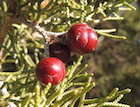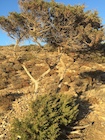Juniperus turbinata
Guss. 1844
Common names
Taxonomic notes
Type: Montallegro, Sicily; G. Gasparrini s.n. Historically this was regarded as a variety or subspecies of Juniperus phoenicea, but over time many different lines of evidence have revealed a strong and consistent division between the two taxa, with chemical, molecular, morphological, phenological and ecological differences warranting recognition at species rank (Adams et al. 1996, 2002, 2009, 2013; Arista et al. 1997; Adams 2006; Boratyński et al. 2009; Mazur et al. 2016). The most detailed molecular studies done to date (summarized in Juniperus) show the two species to be sisters in a highly distinctive clade within Section Sabina, not particularly closely related to any other junipers. Mazur et al. (2016) estimate that the two species diverged within the last two million years, while Mao et al. (2010) estimate the phoenicia-turbinata clade to be more than 30 million years old.
Synonymy:
- Sabina turbinata (Guss.) Antoine 1857;
- Juniperus phoenicia L. var. turbinata (Guss.) Parl. 1868;
- Juniperus phoenicia L. subsp. turbinata (Guss.) Nyman 1881.
J. phoenicea and J. turbinata are a good example of something we've seen a lot of since molecular taxonomy became popular: two species that seldom or never hybridize, but that have almost identical morphology. There are minor morphology differences if you know what to look for, but they are very subtle, certainly not of the prominence that is commonly used to draw a line between different species. However, they are very dissimilar in their ecology, and they have a means of reproductive isolation - flowering at different times of the year - that facilitates evolution into differing ecological roles. If you encounter these taxa in the field, they will generally be easy to distinguish; if you're in Spain or France, in the mountains, in an area with over 600 mm of rainfall per year, you are in J. phoenicea country; if you're almost anywhere else in the Mediterranean, or near the seashore, in a hot place with less than 400 mm of rainfall per year, you're in J. turbinata country. Only in coastal southern Spain are the two species sympatric, and there morphological measurements are needed to distinguish them.
Description
Monoecious or dioecious evergreen shrubs, or trees to 8 m tall. Bark on older trees brown, exfoliating in strips. Twigs 1 mm diameter, round, scaly. Leaves both whip and scale-like. Whip leaves on juvenile plants, 5-14 × 0.5-1 mm, acute, mucronate, with two stomatal bands on both adaxial and abaxial surfaces. Scale leaves on adult plants 0.7-1 mm long, ovate-rhombic, closely appressed, obtuse, with an oblong furrowed gland and a scarious border. Seed cones 7-11 mm diameter, ripening in the 2nd year, turbinate, changing from blackish to green or yellowish, sometimes slightly pruinose; dark red at maturity. Seeds (3-)4-7(-10) per cone. 2n=22. Pollen shed October-November (Adams 2014).
Compared to J. phoenicea, the leaves are more elongate and more acute, and the seed cones a bit larger, mostly 12-14 mm diameter (Farjon 2010). J. phoenicea cones average 8 seeds, while J. turbinata averages 5-6 seeds (Mazur et al. 2003). Also, even in sympatric populations, J. turbinata sheds pollen in October-November while J. phoenicea does so in February-March (Arista et al. 1997); see Mazur et al. (2016) for detailed discussion of morphological differences and their statistical significance. All in all, it is quite difficult to distinguish the two species unless you see them in flower or have a number of ripe seed cones to measure.
Distribution and Ecology
Albania; Algeria; Croatia; Cyprus; Egypt; France; Greece; Italy (including Sardinia and Sicily); Jordan; Libya; Malta (probably); Morocco; Portugal; Saudi Arabia; Spain (including the Canary and Balearic Islands); Tunisia; Turkey (Adams et al. 2013, Mazur et al. 2016). Found at elevations of 0-2000 m; at coastal elevations it appears to be restricted to the hottest of the Mediterranean climates in areas with 400-800 mm annual precipitation, while mountain occurrences are all in the relatively hot/dry region of north Africa in cooler areas that receive about 200 mm annual precipitation (Mazur et al. 2016). Commonly on limestone in the mountains; otherwise on rocky and sandy seashores (Adams 2014).
The conservation status is "near threatened" due to habitat loss associated with coastal development (mainly due to tourism), and a small area of occupancy and very high level of population fragmentation, despite the very large area of occurrence. Rates of decline are not known; if ongoing decline were demonstrated, it may warrant "vulnerable" status. This species is present in several coastal reserves (Farjon 2020).
Remarkable Specimens
No data as of 2023.03.03.
Ethnobotany
No data as of 2023.02.21.
Observations
No data as of 2023.02.21.
Remarks
The epithet refers to the turbinate seed cone, i.e. shaped like a spinning top.
Citations
Adams, R. P. 2006. Geographic variation in Juniperus phoenicea from the Canary Islands, Morocco and Spain, based on RAPDs analysis. Phytologia 88(3):270–278.
Adams, R. P. 2014. Junipers of the World, 4th ed. Trafford, Bloomington, IN. 415 p.
Adams, R. P., A. F. Barrero, and A. Lara. 1996. Comparisons of the leaf essential oils of Juniperus phoenicea, J. phoenicea subsp. eu-mediterranea Lehr. & Thiv. and J. phoenicea var. turbinata (Guss.) Parl. Journal of Essential Oil Research 8:367–371.
Adams, R. P., R. N. Pandey, S. Rezzi, and J. Casanova. 2002. Geographic variation in the Random Amplified Polymorphic DNAs (RAPDs) of Juniperus phoenicea, J. p. var. canariensis, J. p. subsp. eu-mediterranea, and J. p. var. turbinata. Biochemical Systematics and Ecology 30(3):223–229.
Adams, R. P., B. Rumeu, M. Nogales, and S. S. Fontinha. 2009. Geographic variation and systematics of Juniperus phoenicea L. from Madeira and the Canary Islands: Analyses of leaf volatile oils. Phytologia 91(1):40–53.
Adams, R. P., A. Boratynski, M. Arista, A. E. Schwarzbach, H. Leschner, Z. Liber, P. Minissale, T. Mataraci, and A. Manolis. 2013. Analysis of Juniperus phoenicea from throughout its range in the Mediterranean using DNA sequence data from nrDNA and petN-psbM: The case for the recognition of J. turbinata Guss. Phytologia 95(2):202-209.
Arista, M., P. L. Ortiz, and S. Talavera. 1997. Reproductive isolation of two sympatric subspecies of Juniperus phoenicea (Cupressaceae) in southern Spain. Plant Systematics and Evolution 208:225–237.
Boratyński, A., A. Lewandowski, K. Boratyńska, J. M. Montserrat, and A. Romo. 2009. High level of genetic differentiation of Juniperus phoenicea (Cupressaceae) in the Mediterranean region: geographic implications. Plant Syst Evol. 277:163–172.
Farjon, Aljos. 2010. A Handbook of the World's Conifers. Leiden, Netherlands: Brill Academic Publishers.
Farjon, Aljos. 2020. Juniperus turbinata (amended version of 2013 assessment). The IUCN Red List of Threatened Species 2020: e.T16349692A168119952. https://dx.doi.org/10.2305/IUCN.UK.2020-1.RLTS.T16349692A168119952.en. Downloaded on 19 May 2020.
Gussone, G. 1843-1844. Flora Siculae sinopsis exhibens plantas vasculares in Sicilia insulisque adjacentibus huc usque detectas, secundum systema Linneanum dispositas, 1–2. Tramater, Napoli, 582 pp. (vol. 1) + 920 pp. (vol. 2).
Mao, K., G. Hao, J. Liu, R. P. Adams, and R. I. Milne. 2010. Diversification and biogeography of Juniperus (Cupressaceae): variable diversification rates and multiple intercontinental dispersals. New Phytologist 188(1):254–272.
Mazur, M., K. Boratynska, K. Marcysiak, D. Gomez, D. Tomaszewski, J. Didukh and A. Boratynski.
2003. Morphological variability of Juniperus phoenicea (Cupressaceae) from three distant localities
on the Iberian peninsula. Act. Soc. Bot. Poloniae 72:71-78.
Mazur, M., P. Minissale, S. Sciandrello, and A. Boratyński. 2016. Morphological and ecological comparison of populations of Juniperus turbinata Guss. and J. phoenicea L. from the Mediterranean region. Plant Biosystems - An International Journal Dealing with all Aspects of Plant Biology 150(2):313–322.
Sherif, A. S. and A. El-Taife. 1986. Flora of Libya. Al Faateh University Faculty of Science.
See also
Species account at the Flora of Greece, accessed 2020.05.19.
Ferrer-Gallego, P.P., Nazzaro, R., Ferrando, I. and Laguna, E. 2017. Typification of the Mediterranean endemic conifer Juniperus turbinata (Cupressaceae). Phytotaxa 302(2):165-173.








